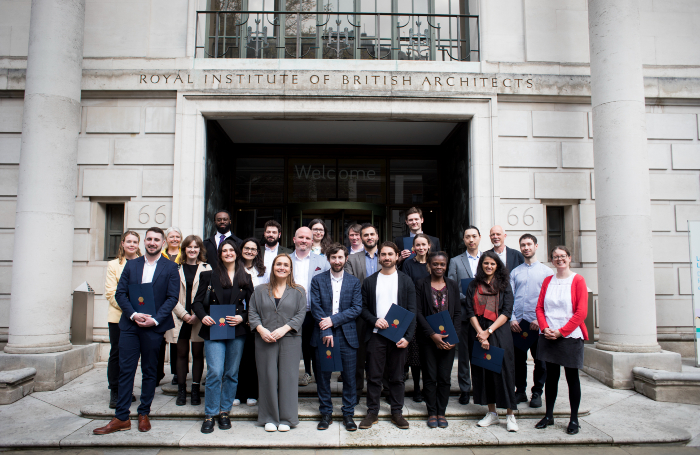Becoming an architect
Explore the different pathways to qualifying as an architect and the role that RIBA plays in architectural education.

“As an architect, you will change the world – quite literally, being responsible for the creation of our built environment, and designing the buildings that surround us and enclose us. Studying architecture is an extraordinary opportunity giving you the potential to make a real difference to people’s lives, impact communities, and directly tackle the climate emergency.”
RIBA’s Director of Education and Learning, Dr Jenny Russell.
Becoming an architect
Are you interested in the field of architecture but not sure where to start?
RIBA Learning, in partnership with Found Futures, proudly presents this captivating short film designed to inform and inspire you about the dynamic pathways to becoming an architect.
Routes to becoming an architect
In the UK, the architecture profession is regulated, and you must register with the Architects Registration Board (ARB) to use the title ‘architect’. The current route to registration involves completion of three qualifications - Part 1, Part 2, and Part 3 - and two years of practical experience. The Architects Registration Board is making changes to the way in which it regulates both the academic and practice-based education process, and RIBA have also provided some answers to Frequently Asked Questions.
After completion of these components, you can register as an architect with the Architects Registration Board (ARB) and join the RIBA as a Chartered Architect.
Most architecture qualifications in the UK are recognised by both ARB (accreditation) and RIBA (validation).
Meet RIBA President, Muyiwa Oki, to hear about his career so far.
Watch a video of RIBA President Muyiwa Oki taking about his career so far.
The role of RIBA in architectural education
RIBA validation: RIBA is a professional membership body for the architecture profession. We validate over 230 architectural programmes at over 120 schools of architecture around the world, preparing students for professional practice. Gaining RIBA validated qualifications puts you on the path to becoming a Chartered Architect and RIBA membership is available at all career stages to support you.
RIBA courses: we also offer our own programmes at Foundation level; RIBA Part 1 and 2 and RIBA Part 3, so we can support you through the whole process of becoming an architect. All our courses on the professional pathway are recognised by the Architects Registration Board.
RIBA lifelong learning: Architecture is an open profession and we welcome learners of all ages and experiences, keen to understand more on the spaces and places in which they live, learn, work, and play. Our learning programme can offer workshops, courses, and activities, inspired by our world-class architectural collections and exhibitions. Our flexible CPD programme also helps architects and construction professionals develop lifelong learning, relevant skills, and core competencies, enabling them to keep resilient and up to date through the RIBA Academy learning portal and the RIBA CPD Providers Network.

The role of Architects Registration Board (ARB)
In the UK, RIBA is not the licensing or registration body; that function is performed by the Architects Registration Board (ARB). The title 'architect' is protected by law and every architect must be listed on the ARB’s Register of Architects, so the public knows they are dealing with a fully qualified architect.
In 2023, ARB announced the outcomes of their consultation Tomorrow’s Architects and confirmed changes to how they will carry out their regulatory duties in relation to architectural education – you can read more in their answers to frequently asked questions. RIBA in turn has published some answers to the questions we have received about the coming changes.
Please contact ARB directly for any further information or queries.
Training as an architect
Some students decide to study a Year 0 (additional year before a Bachelor's degree) or a Foundation course, such as the RIBA Foundation in Architecture, before entering a Part 1 course. This is to gain an insight into architectural or creative professions and create a portfolio in preparation for further studies or work.
If you decide the architecture route is for you, the different options to train are:
- study full-time or part-time via providers – ARB-accredited courses for registration, RIBA validated courses for RIBA membership.
- earn and learn via RIBA Studio (Foundation in Architecture, Part 1, Part 2)
- train as an Architectural Apprentice (Level 6, Level 7)
Discover more on the current routes in our RIBA Study Architecture Well guide (page 14) and architectural training in our RIBA Practise Architecture Well guide.
International routes – EU or international
If you have studied or qualified to be an architect outside the UK or EU (including RIBA validated qualifications completed outside the UK or EU), your qualification(s) will need to be assessed for equivalence to the UK Parts 1 and 2, by the Architects Registration Board (ARB).
You will also need to undertake a UK Part 3 to be eligible to apply for registration with ARB. Some overseas agreements have been developed by ARB and specific countries, and there is still some continuing recognition for those with qualifications recognised under the EU Professional Qualifications Directive. Please contact ARB for further information.
If you’re an architect registered and practising outside the UK and EU, you can apply for international RIBA Chartered Membership through MEAP. This is a process to gain international Chartered Membership status only.
We are not able to advise on visas or sponsoring licences – please check out the UK Government website.

Career change into architecture
If you're working in the wider profession as an architectural technologist, interior designer, or engineer, there isn't currently a simple way to convert into architecture. However, the ARB’s reform of architectural education could bring significant changes in the coming years. Keep updated on ARB's website.
Currently, you would need to undertake the Part 1, 2, and 3 qualifications and 24 months' practical training. Universities may offer some flexibility in entering a course in the later stages, based on your experience and prior academic credit. This is at their discretion and you should speak with them directly for advice.
Funding your studies
Here, you will find information on how to fund your architecture studies and our scholarships, bursaries, and opportunities available.

Practical experience and PEDR tool
To qualify as an architect, a minimum of two years' practical experience is also required. The RIBA’s PEDR tool is the recognised format to record this training and the PEDR documents are submitted for the UK Part 3 exam. Usually, students log PEDR sheets during the periods in practice, working alongside professionals in the construction industry or architects in the UK and around the world.
You can check out RIBA Jobs board if you’re looking for employment, as well as our Study/Practise Well guides and Future Architects prep for practise resources for tips on job hunting.








